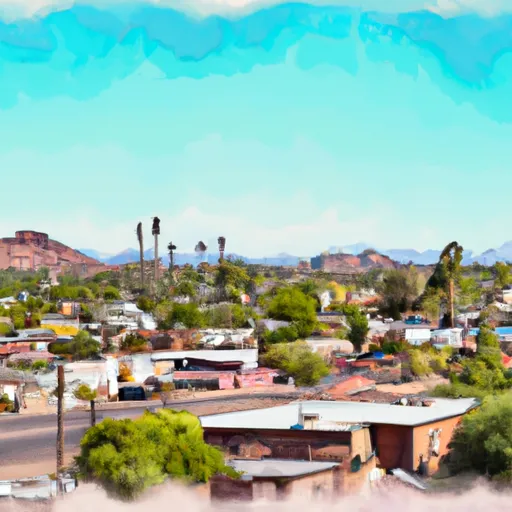-
 Snoflo Premium
Snoflo Premium
Get unlimited access to all our content
With no Ad interruptions! - Start Your Free Trial Login with existing account
Wickenburg
Eden Index
Climate
8.8
•
Recreation
2.8
•
Community
2.4
•
Safeguard
5.1/10

Wickenburg, Arizona is a charming town situated northwest of Phoenix. Known for its rich history and Old West charm, Wickenburg offers an arid desert climate with hot summers and mild winters. Summers are characterized by high temperatures averaging in the mid-90s°F, while winters are mild, with temperatures ranging from the mid-50s°F to mid-60s°F.
Hydrologically, Wickenburg lies near the Hassayampa River, and its surrounding area features numerous washes and creeks that enhance the scenic beauty of the region. However, water scarcity is a concern, with limited annual rainfall and reliance on groundwater sources.
Outdoor enthusiasts can enjoy various recreational activities in Wickenburg. The town is surrounded by beautiful desert landscapes, making it an ideal destination for hiking, mountain biking, and horseback riding. Nature lovers can explore nearby regional parks and wildlife preserves, such as Vulture Mountain Recreation Area and Hassayampa River Preserve, offering opportunities for birdwatching and wildlife spotting. Additionally, Wickenburg is renowned for its gold mining history, providing visitors with the chance to try their hand at gold panning and prospecting. Overall, Wickenburg offers a unique blend of history, natural beauty, and outdoor adventure, making it a captivating destination for visitors.
What is the Eden Index?
The Snoflo Eden Index serves as a comprehensive rating system for regions, evaluating their desirability through a holistic assessment of climate health, outdoor recreation opportunities, and natural disaster risk, acknowledging the profound impact of these factors on livability and well-being.
Climate Health Indicator (CHI): 8.8
Wickenburg receives approximately
291mm of rain per year,
with humidity levels near 46%
and air temperatures averaging around
20°C.
Wickenburg has a plant hardyness factor of
9, meaning
plants and agriculture in this region tend to thrive here all year round.
By considering the ideal temperature range, reliable water supplies, clean air, and stable seasonal rain or snowpacks, the Climate Health Indicator (CHI) underscores the significance of a healthy climate as the foundation for quality living.
A healthy climate is paramount for ensuring a high quality of life and livability in a region, fostering both physical well-being and environmental harmony. This can be characterized by ideal temperatures, reliable access to water supplies, clean air, and consistent seasonal rain or snowpacks.
Weather Forecast
Streamflow Conditions
Lower Gila-Agua Fria
Area Rivers
Lower Gila-Agua Fria
Snowpack Depths
Lower Gila-Agua Fria
Reservoir Storage Capacity
Lower Gila-Agua Fria
Groundwater Levels
Recreational Opportunity Index (ROI): 2.8
The Recreational Opportunity Index (ROI) recognizes the value of outdoor recreational options, such as parks, hiking trails, camping sites, and fishing spots, while acknowledging that climate plays a pivotal role in ensuring the comfort and consistency of these experiences.
Access to outdoor recreational opportunities, encompassing activities such as parks, hiking, camping, and fishing, is crucial for overall well-being, and the climate plays a pivotal role in enabling and enhancing these experiences, ensuring that individuals can engage in nature-based activities comfortably and consistently.
Camping Areas
| Campground | Campsites | Reservations | Toilets | Showers | Elevation |
|---|---|---|---|---|---|
| Ghost Town Rd. Congress Dispersed | None | 3,194 ft | |||
| Constellation Park | 30 | 2,223 ft | |||
| Vulture Peak Rd - Box Wash dispersed | None | 2,541 ft |
Nearby Ski Areas
Catastrophe Safeguard Index (CSI):
The Catastrophe Safeguard Index (CSI) recognizes that natural disaster risk, encompassing floods, fires, hurricanes, and tornadoes, can drastically affect safety and the overall appeal of an area.
The level of natural disaster risk in a region significantly affects safety and the overall livability, with climate change amplifying these risks by potentially increasing the frequency and intensity of events like floods, fires, hurricanes, and tornadoes, thereby posing substantial challenges to community resilience and well-being.
Community Resilience Indicator (CRI): 2.4
The Community Resilience Indicator (CRI) recognizes that education, healthcare, and socioeconomics are crucial to the well-being of a region. The CRI acknowledges the profound impact of these elements on residents' overall quality of life. By evaluating educational resources, healthcare accessibility, and economic inclusivity, the index captures the essential aspects that contribute to a thriving community, fostering resident satisfaction, equity, and social cohesion.

